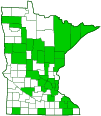laurel sphinx
(Sphinx kalmiae)
Conservation • Description • Habitat • Ecology • Distribution • Taxonomy
|
|
||||||||||||||||||
Description |
Laurel sphinx is a common, large, small-eyed sphinx moth. It occurs in the United States east of the Great Plains and in adjacent Canadian provinces. Adults are 1 9 ⁄16″ to 2 3 ⁄16″ (40 to 55 mm) long and have a wingspan of 3″ to 4″ (75 to 103 mm). The abdomen is long tapered. The forewing is long, pointed, and mostly light yellowish-brown. There is a broad dark brown to black patch along the inner margin and dark brown scales on the veins. The patch extends onto the rear margin, where it narrows and disappears before reaching the wing tip, and is bordered by a thin but bold white subterminal line. The reniform spot, in the lower median area, is black and tiny. The hindwing is pale tan with two broad dark brown to black bands, one in the median area, one in the postmedial area. The caterpillar is bluish-green or yellowish-green and up to 3⅛″ long. There are seven oblique stripes on each side of the body. They are each composed of a thin black line above, a thin white line in the middle, and a broader yellow line below. A long blue horn covered with minute black spines extends from the eighth abdominal segment. The breathing pores (spiracles) are orange. There are four leg-like structures (prolegs) on the abdomen. Each proleg has a shiny black band at the tip bordered by black crescents. There is a black line on the head bordered on each side by broader yellowish green areas. Mature caterpillars are found from June onward. |
Size |
Total length: 1 9 ⁄16″ to 2 3 ⁄16″ (40 to 55 mm) Wingspan: 3″ to 4″ (75 to 103 mm) |
Similar Species |
Habitat |
Forests and woodlands |
Ecology |
Season |
One generation per year: Late May to early August |
Behavior |
Adults are active at night and are attracted to lights. The forewings are held close to the body when at rest, giving the moth a slender appearance. |
Life Cycle |
Pupa overwinter in the soil. |
Larva Hosts |
Leaves of mostly ash but also birch and lilac |
Adult Food |
Flower nectar |
Distribution |
||
|
Sources |
|
| 9/2/2024 | ||
Occurrence |
||
Common |
||
Taxonomy |
|
Order |
|
Superfamily |
Bombycoidea (Hawk, Sphinx, Silk, Emperor, and Allied Moths) |
Family |
|
Subfamily |
Sphinginae (large sphinx moths) |
Tribe |
Sphingini |
Subtribe |
Sphingina |
Genus |
Sphinx |
Subordinate Taxa |
|
|
|
Synonyms |
|
|
|
Common Names |
|
fawn sphinx fawn sphinx moth laurel sphinx |
|
The common name laural sphinx is a misnomer arising from the mistaken belief that the species epithet kalmiae referred to the laural plant genus Kalmia. In fact, it refers to the botanist Pehr Kalm, after whom the insect was named. |
|
Glossary
Reniform spot
A kidney-shaped spot or outline in the lower median area near the PM line on the forewing of many moths.
Proleg
A fleshy structure on the abdomen of some insect larvae that functions as a leg, but lacks the five segments of a true insect leg.
Spiracle
A small opening on the surface of an insect or arachnid through which it breathes.
Visitor Photos |
||
Share your photo of this insect. |
||
This button not working for you? |
||
Alfredo Colon |
||
 |
 |
|
 |
 |
|
 |
 |
|
 |
||
MinnesotaSeasons.com Photos |
||
|
||
|
||

Visitor Videos |
||
Share your video of this insect. |
||
This button not working for you? |
||
|
Other Videos |
||
Laurel Sphinx Caterpillar |
About
Published on Sep 13, 2015 Laurel Sphinx Caterpillar |

Created: 9/22/2019 Last Updated: © MinnesotaSeasons.com. All rights reserved. |





